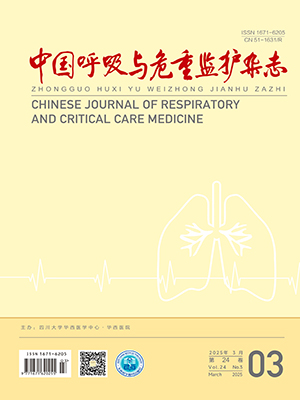Objective To assess the lung capacity and diffusing capacity in patients with chronic persistent asthma with different severities.
Methods Patients diagnosed with chronic persistent asthma in West China Hospital between January 2014 and April 2015 were recruited in the study.The data of clinical characteristics were collected.The forced expiratory volume in the first second (FEV1) was determined by spirometry test.Total lung capacity (TLC) and residual volume (RV) were determined by body plethysmography and helium dilution method.Single breath diffusing capacity for carbon monoxide (DLCO) was also measured.Lung capacity and the deviations between two methods, and DLCO%pred were compared among different patient groups with mild, moderate and severe asthmas.The correlation between spirometry with lung capacity and DLCO%pred were analyzed.
Results A total of 93 patients with chronic persistent asthma were enrolled.With the severity of asthma, TLC%pred, RV%pred, RV/TLC and the deviations of the ones between two methods increased significantly, but DLCO%pred reduced slightly.FEV1%pred were negatively correlative with the deviations of lung capacity between two methods, and positively correlative with DLCO%pred.
Conclusions Compared with helium dilution method, the body plethysmography is more accurate for evaluating the lung capacity of chronic persistent asthma.With the severity of airflow limitation, the diffusing capacity of asthma is decreasing gradually, but still within the normal limits.
Citation:
DuJing, LiLinwei, ZuPing, DengYan, HeTailing, YuanYuru, LiangBinmiao. Lung Capacity and Diffusing Capacity in Patients with Chronic Persistent Asthma with Different Severities. Chinese Journal of Respiratory and Critical Care Medicine, 2016, 15(1): 60-63. doi: 10.7507/1671-6205.2016015
Copy
Copyright © the editorial department of Chinese Journal of Respiratory and Critical Care Medicine of West China Medical Publisher. All rights reserved
| 1. |
Global Initiative for Asthma (GINA) 2014:Global strategy for asthma management and prevention. http://www.ginasthma.org.
|
| 2. |
中华医学会呼吸病学分会肺功能专业组.肺功能检查指南-肺容量检查.中华结核和呼吸杂志, 2014, 38:255-260.
|
| 3. |
中华医学会呼吸病学分会肺功能专业组.肺功能检查指南-肺弥散功能检查.中华结核和呼吸杂志, 2014, 38:163-169.
|
| 4. |
中华医学会呼吸病学分会哮喘学组.支气管哮喘防治指南(支气管哮喘的定义、诊断、治疗和管理方案).中华哮喘杂志(电子版), 2008, 2:3-13.
|
| 5. |
中华医学会呼吸病学分会肺功能专业组.肺功能检查指南(第二部分)-肺量计检查.中华结核和呼吸杂志, 2014, 37:481-486.
|
| 6. |
Maselli R, Paciocco G. Asthma:pathophysiology of the bronchial obstruction. Allergy, 2000, 61:49-51.
|
| 7. |
Ding DJ, Martin JG, Macklem PT. Effects of lung volume on maximal methacholine-induced bronchoconstriction in normal humans. J Appl Physiol, 1987, 62:1324-1330.
|
| 8. |
O Donnell CR, Bankier AA, Stiebellehner L, et al. Comparison of plethysmographic and helium dilution lung volumes:which is best for COPD? Chest, 2010, 137:1108-1115.
|
| 9. |
Shaw RJ, Djukanovic R, Tashkin DP, et al. The role of small airways in lung disease. Respir Med, 2002, 96:67-80.
|
| 10. |
van der Lee I, Zanen P, van den Bosch JM, et al. Pattern of diffusion disturbance related to clinical diagnosis:The KCO has no diagnostic value next to the DLCO. Respir Med, 2006, 100:101-109.
|
| 11. |
Gelb AF, Licuanan J, Shinar CM, et al. Unsuspected loss of lung elastic recoil in chronic persistent asthma. Chest, 2002, 121:715-721.
|
| 12. |
Boulet LP, Lemière C, Archambault F, et al. Smoking and asthma:clinical and radiologic features, lung function, and airway inflammation. Chest, 2006, 129:661-668.
|
- 1. Global Initiative for Asthma (GINA) 2014:Global strategy for asthma management and prevention. http://www.ginasthma.org.
- 2. 中华医学会呼吸病学分会肺功能专业组.肺功能检查指南-肺容量检查.中华结核和呼吸杂志, 2014, 38:255-260.
- 3. 中华医学会呼吸病学分会肺功能专业组.肺功能检查指南-肺弥散功能检查.中华结核和呼吸杂志, 2014, 38:163-169.
- 4. 中华医学会呼吸病学分会哮喘学组.支气管哮喘防治指南(支气管哮喘的定义、诊断、治疗和管理方案).中华哮喘杂志(电子版), 2008, 2:3-13.
- 5. 中华医学会呼吸病学分会肺功能专业组.肺功能检查指南(第二部分)-肺量计检查.中华结核和呼吸杂志, 2014, 37:481-486.
- 6. Maselli R, Paciocco G. Asthma:pathophysiology of the bronchial obstruction. Allergy, 2000, 61:49-51.
- 7. Ding DJ, Martin JG, Macklem PT. Effects of lung volume on maximal methacholine-induced bronchoconstriction in normal humans. J Appl Physiol, 1987, 62:1324-1330.
- 8. O Donnell CR, Bankier AA, Stiebellehner L, et al. Comparison of plethysmographic and helium dilution lung volumes:which is best for COPD? Chest, 2010, 137:1108-1115.
- 9. Shaw RJ, Djukanovic R, Tashkin DP, et al. The role of small airways in lung disease. Respir Med, 2002, 96:67-80.
- 10. van der Lee I, Zanen P, van den Bosch JM, et al. Pattern of diffusion disturbance related to clinical diagnosis:The KCO has no diagnostic value next to the DLCO. Respir Med, 2006, 100:101-109.
- 11. Gelb AF, Licuanan J, Shinar CM, et al. Unsuspected loss of lung elastic recoil in chronic persistent asthma. Chest, 2002, 121:715-721.
- 12. Boulet LP, Lemière C, Archambault F, et al. Smoking and asthma:clinical and radiologic features, lung function, and airway inflammation. Chest, 2006, 129:661-668.




